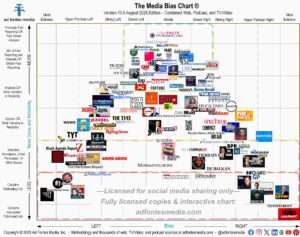
It’s Media Literacy Week! Ad Fontes Media Promotes Media Literacy Excellence
Author:
Jennifer Arvin Furlong
Date:
10/26/2023
Ad Fontes Media is committed to improving citizens’ understanding of the complex media landscape, and we think it’s important to begin teaching these skills in the classroom. Our team has created a curriculum of lesson plans and instructor resources just in time for Media Literacy Week!
Media Literacy Week serves as an annual checkpoint in our journey to develop skills to sift through the deluge of information we encounter every day. Advocates describe it as an opportunity to celebrate media literacy and bring attention to important aspects of it including how to access and evaluate the information we consume on a local, national, and international level. Recognizing the importance of media literacy, the United Nations has called on the global community to increase its commitment to media and information literacy in observance of Global Media and Information Literacy Week 2023.
As the Communications Director for Ad Fontes Media (AFM) and Board President for Media Literacy Now (MLN), this is a topic I care deeply about. Being able to discern fact from fiction is becoming more and more difficult in today’s age of technologically advanced communications systems and hyper-polarized media.
Today’s media landscape and the challenges that come with it underscores the importance of fostering a culture of critical analysis and thoughtful engagement with media content. At its heart lies the recognition that media literacy is not just a desirable skill, but an indispensable one, empowering individuals to become active participants rather than passive consumers of information.
Organizations like AFM and MLN play crucial roles in promoting media literacy and fostering a more informed and discerning society. While their specific missions might differ, together they underscore the need for a holistic approach to media literacy.
Media Literacy Now focuses on advocating for and driving K-12 education policy change at local, state, and national levels in the U.S. It wants to ensure that students at every level learn critical thinking skills to navigate the digital age effectively. To accomplish this goal, it goes beyond raising media literacy awareness. It connects state advocates to policymakers, influences legislation, and supports implementation of media literacy education in schools.
Ad Fontes Media specializes in media bias and reliability analysis. Its Media Bias Chart® (MBC) has revolutionized the way we evaluate and perceive news and news-like sources. It has become an important tool to help provide a path to clarity when consuming information from our complex media landscape.
The MBC provides a comprehensive, visual representation of the political bias and reliability of various news and news-like sources, enabling users to make informed decisions about the credibility of the information they consume. By offering a transparent and accessible tool for assessing the reliability and bias of news outlets, AFM has become an essential leader in media literacy education.
One thing that I appreciate about both organizations is their commitment to maintaining a non-partisan stance to ensure credibility, build and sustain trust, and reach audiences with diverse political points of view. This is crucial for promoting and implementing media literacy education and providing assessments of media bias and reliability.
Together, these organizations underscore the importance of promoting a holistic approach to media literacy, integrating theory and practical application. This comprehensive approach can empower individuals to become more discerning consumers of information, fostering a media-savvy society and well-informed citizenry.
As we celebrate Media Literacy Week and prepare for another election cycle, we are reminded of the significance of nurturing a media-literate society. The ability to navigate the media landscape helps safeguard against manipulation, ensures the dissemination of reliable information and politically diverse points of view, promotes active participation in democratic processes, and ultimately strengthens the foundation of our democracy. With organizations like Ad Fontes Media and Media Literacy Now, we can pave the way for a more responsible and media-literate society.
If you’re an educator interested in learning more about how you can use the Media Bias Chart as a teaching tool in your classroom, check out our educational tools for librarians, faculty, and students.
Stay informed and subscribe to Media Literacy Now’s newsletter to receive updates on state legislation or to get connected to advocates in your state. To stay informed on all of the work being done by the Ad Fontes Media team, join our mailing list!


